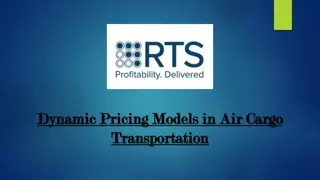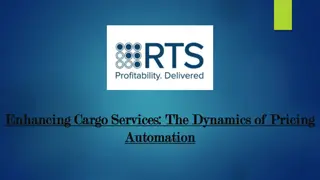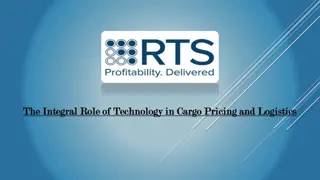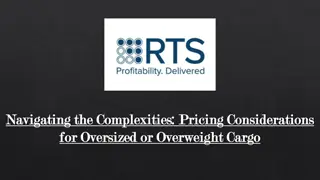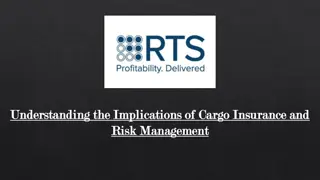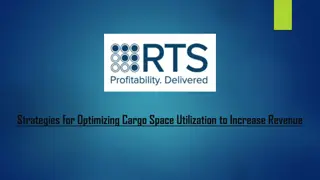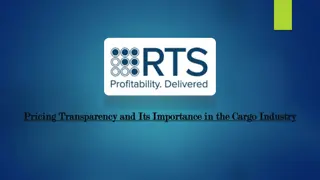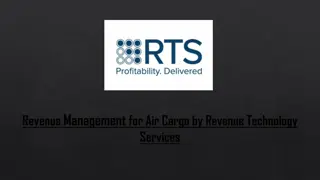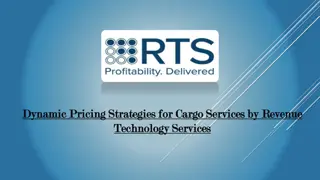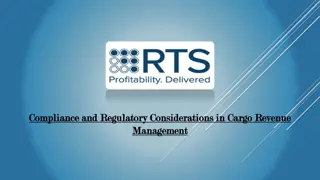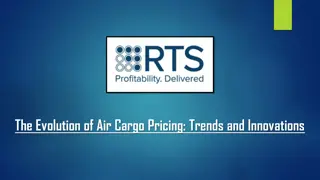Real-Time Pricing Models The Future of Air Cargo Pricing
In the dynamic world of air cargo, traditional pricing strategies are becoming obsolete. The industry is moving towards real-time pricing models, a significant shift that is revolutionizing how air cargo pricing is determined and managed. This change
Download Presentation

Please find below an Image/Link to download the presentation.
The content on the website is provided AS IS for your information and personal use only. It may not be sold, licensed, or shared on other websites without obtaining consent from the author.If you encounter any issues during the download, it is possible that the publisher has removed the file from their server.
You are allowed to download the files provided on this website for personal or commercial use, subject to the condition that they are used lawfully. All files are the property of their respective owners.
The content on the website is provided AS IS for your information and personal use only. It may not be sold, licensed, or shared on other websites without obtaining consent from the author.
E N D
Presentation Transcript
In the dynamic world of air cargo, traditional pricing strategies are becoming obsolete. The industry is moving towards real-time pricing models, a significant shift that is revolutionizing how air cargo pricing is determined and managed. This change is driven by advancements in technology, particularly in data analytics and machine learning, which are enabling more accurate and flexible pricing strategies. Revenue Technology Services (RTS) is at the forefront of this transformation, leveraging cutting-edge solutions to help airlines optimize their pricing strategies and maximize profitability.
The Need for Real-Time Pricing The air cargo industry faces several challenges, including fluctuating demand, variable fuel prices, and intense competition. Traditional pricing models, which rely on historical data and fixed pricing structures, are often inadequate in responding to these rapidly changing conditions. Real-time pricing models address this gap by using current data to adjust prices dynamically. This approach allows airlines to respond immediately to market changes, ensuring that prices reflect the true value of the service at any given moment. How Real-Time Pricing Works Real-time pricing models utilize advanced algorithms and data analytics to continuously monitor various factors that influence pricing. These factors include cargo demand, available capacity, fuel prices, and even weather conditions. By analyzing this data in real-time, airlines can adjust their prices instantly, offering more competitive rates while maximizing revenue. For instance, during periods of high demand, real-time pricing can help airlines capitalize on the willingness of shippers to pay higher rates for timely delivery. Conversely, during low demand periods, airlines can lower prices to attract more business and fill unused cargo space. This dynamic approach ensures optimal pricing at all times, benefiting both the airline and its customers.
Benefits of Real-Time Pricing 1.Increased Revenue: By adjusting prices in real-time, airlines can maximize their revenue potential. Higher prices during peak times and optimized rates during off-peak times ensure that no revenue opportunity is missed. 2.Improved Efficiency: Real-time pricing models streamline the pricing process, reducing the need for manual adjustments and allowing pricing teams to focus on strategic decisions. This efficiency translates to cost savings and better resource allocation. 3.Enhanced Customer Satisfaction: Customers benefit from more transparent and fair pricing. Real-time pricing models can provide more competitive rates, attracting a broader customer base and improving overall satisfaction. 4.Competitive Advantage: Airlines that adopt real-time pricing models gain a significant edge over competitors still using traditional pricing methods. The ability to respond swiftly to market changes and offer optimized pricing positions these airlines as industry leaders.
Implementation Challenges Despite the clear benefits, implementing real-time pricing models comes with challenges. It requires significant investment in technology and infrastructure, as well as a cultural shift within the organization. Employees must be trained to understand and work with the new pricing systems, and there may be resistance to change. However, the long-term benefits far outweigh the initial hurdles. With the right strategy and support from technology partners like Revenue Technology Services, airlines can successfully transition to real-time pricing models and reap the rewards. Conclusion Real-time pricing models represent the future of air cargo pricing. By leveraging advanced technology and data analytics, airlines can optimize their pricing strategies, improve efficiency, and enhance customer satisfaction. Revenue Technology Services is leading the way in this transformation, offering innovative solutions that help airlines navigate the complexities of real-time pricing. As the industry continues to evolve, those who embrace this shift will be well-positioned for success in the competitive world of air cargo.




